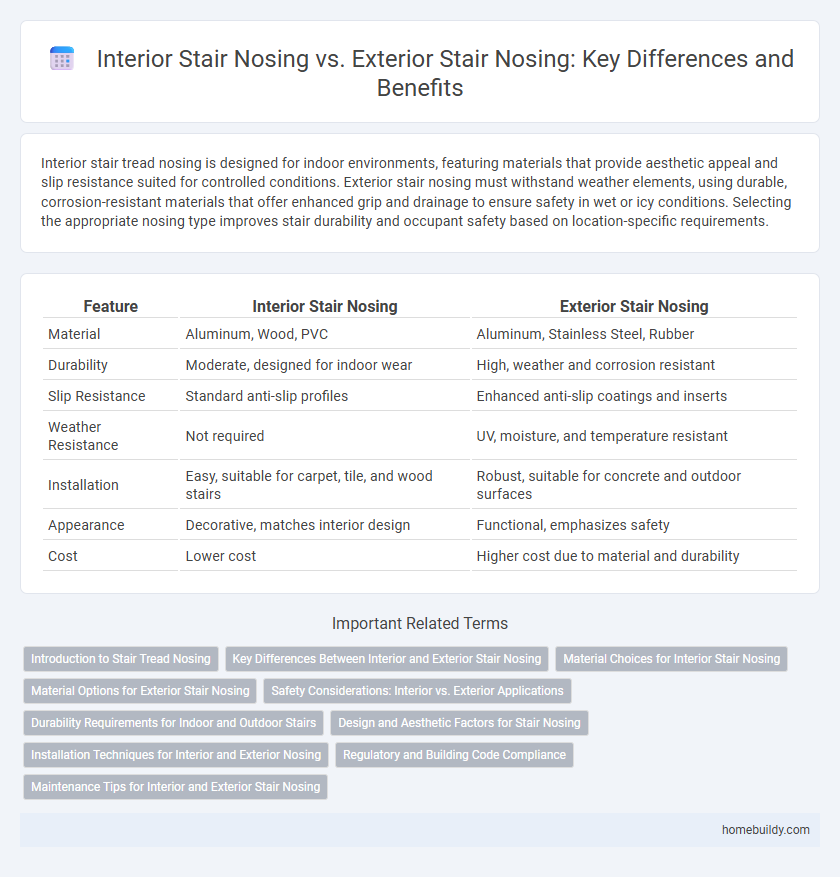Interior stair tread nosing is designed for indoor environments, featuring materials that provide aesthetic appeal and slip resistance suited for controlled conditions. Exterior stair nosing must withstand weather elements, using durable, corrosion-resistant materials that offer enhanced grip and drainage to ensure safety in wet or icy conditions. Selecting the appropriate nosing type improves stair durability and occupant safety based on location-specific requirements.
Table of Comparison
| Feature | Interior Stair Nosing | Exterior Stair Nosing |
|---|---|---|
| Material | Aluminum, Wood, PVC | Aluminum, Stainless Steel, Rubber |
| Durability | Moderate, designed for indoor wear | High, weather and corrosion resistant |
| Slip Resistance | Standard anti-slip profiles | Enhanced anti-slip coatings and inserts |
| Weather Resistance | Not required | UV, moisture, and temperature resistant |
| Installation | Easy, suitable for carpet, tile, and wood stairs | Robust, suitable for concrete and outdoor surfaces |
| Appearance | Decorative, matches interior design | Functional, emphasizes safety |
| Cost | Lower cost | Higher cost due to material and durability |
Introduction to Stair Tread Nosing
Stair tread nosing enhances safety and durability by providing a visible, slip-resistant edge on each step to prevent falls and protect the stair structure from wear. Interior stair nosing typically features materials like rubber, wood, or carpet inserts designed for aesthetic appeal and indoor use, while exterior stair nosing requires weather-resistant materials such as aluminum or galvanized steel to withstand outdoor elements. Proper installation of stair tread nosing improves traction and extends stair longevity, making it essential for both commercial and residential staircases.
Key Differences Between Interior and Exterior Stair Nosing
Interior stair nosing typically features materials like carpet, vinyl, or wood, designed for aesthetic appeal and indoor durability, while exterior stair nosing uses weather-resistant materials such as aluminum or rubber to withstand harsh climatic conditions. Interior nosing prioritizes slip resistance and comfort for foot traffic inside buildings, whereas exterior nosing focuses on enhanced grip and drainage to prevent water accumulation and ice formation. The installation methods also differ, with interior stair nosing often integrated into finished floors and exterior nosing requiring robust anchoring systems for outdoor exposure.
Material Choices for Interior Stair Nosing
Interior stair tread nosing typically uses materials such as hardwood, aluminum, and vinyl that offer a balance of durability and aesthetic appeal in indoor environments. Hardwood provides a warm, natural look, while aluminum offers sleek modernity and resistance to wear in high-traffic areas. Vinyl nosing is favored for its cost-effectiveness, slip resistance, and ease of maintenance, making it suitable for residential and commercial interior stairs.
Material Options for Exterior Stair Nosing
Exterior stair nosing requires durable, weather-resistant materials such as aluminum, stainless steel, or PVC to withstand harsh outdoor conditions and prevent slip hazards. Aluminum offers corrosion resistance and lightweight strength, while stainless steel provides superior durability and rust prevention ideal for high-traffic areas. PVC stair nosing combines affordability with water resistance and is often reinforced with anti-slip surfaces suited for various exterior applications.
Safety Considerations: Interior vs. Exterior Applications
Interior stair nosing often prioritizes slip resistance and visibility in controlled environments, utilizing materials like vinyl or aluminum with abrasive surfaces to enhance safety. Exterior stair nosing requires durable, weather-resistant materials such as rubber or galvanized steel, designed to withstand moisture, temperature fluctuations, and UV exposure to prevent slips and corrosion. Safety considerations for exterior applications include enhanced drainage and corrosion resistance, whereas interior nosings focus more on aesthetic integration and compliance with indoor building codes.
Durability Requirements for Indoor and Outdoor Stairs
Interior stair nosing requires materials with moderate durability to withstand foot traffic and typical indoor conditions, often utilizing softer metals or vinyl for aesthetic integration and slip resistance. Exterior stair nosing demands high durability with weather-resistant materials such as aluminum or stainless steel, able to resist corrosion, moisture, UV exposure, and temperature fluctuations. Choosing an appropriate nosing product based on environmental exposure significantly enhances safety and extends the lifespan of both indoor and outdoor stairs.
Design and Aesthetic Factors for Stair Nosing
Interior stair nosing emphasizes sleek, polished designs that complement indoor decor, often featuring materials like aluminum with decorative inserts or wood finishes for a seamless aesthetic. Exterior stair nosing prioritizes durability and weather resistance, using robust materials such as stainless steel or non-slip rubber that maintain safety without compromising visual appeal. Both types balance functional safety with style, ensuring staircases enhance overall architectural design while meeting specific environmental demands.
Installation Techniques for Interior and Exterior Nosing
Interior stair tread nosing installation often involves precise cutting to fit carpet, wood, or laminate materials, using adhesives and screws for secure attachment while ensuring a smooth finish that complements indoor aesthetics. Exterior stair nosing requires weather-resistant materials like aluminum or rubber and specialized installation methods including drainage considerations, anti-slip coatings, and corrosion-resistant fasteners to withstand harsh environmental conditions. Proper alignment and anchoring techniques are critical in both settings to ensure safety, durability, and compliance with building codes.
Regulatory and Building Code Compliance
Interior stair nosing and exterior stair nosing must comply with distinct regulatory and building code requirements due to their differing exposure and safety standards. Interior stair nosing regulations prioritize slip resistance and visibility under controlled environments, often referencing standards like ADA (Americans with Disabilities Act) guidelines. Exterior stair nosing demands enhanced durability, weather resistance, and non-slip surfaces compliant with local building codes such as the International Building Code (IBC) and specific state or municipal regulations addressing outdoor safety.
Maintenance Tips for Interior and Exterior Stair Nosing
Interior stair nosing requires regular dusting and the application of wood polish or sealant to prevent wear and maintain appearance, especially in high-traffic areas. Exterior stair nosing demands frequent cleaning to remove dirt, debris, and moisture, alongside inspections for corrosion or damage from weather exposure to ensure safety and longevity. Using appropriate materials such as anti-slip rubber for interiors and weather-resistant aluminum or stainless steel for exteriors enhances durability and reduces maintenance effort.
Interior stair nosing vs Exterior stair nosing Infographic

 homebuildy.com
homebuildy.com